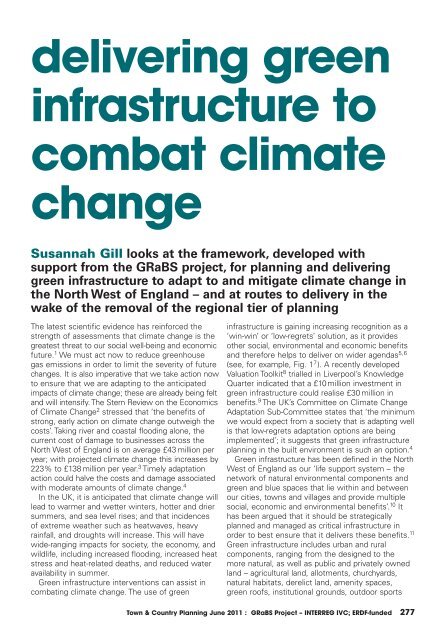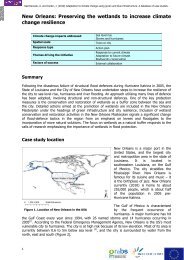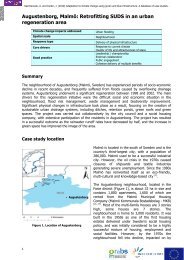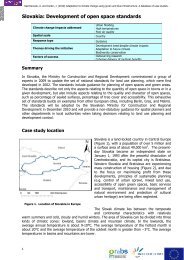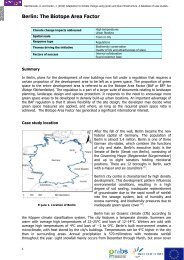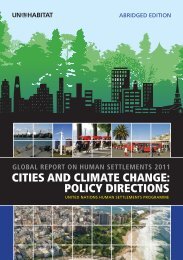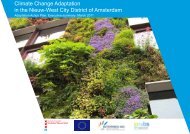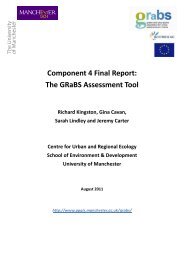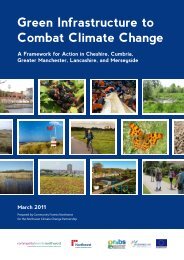Download - GRaBS
Download - GRaBS
Download - GRaBS
Create successful ePaper yourself
Turn your PDF publications into a flip-book with our unique Google optimized e-Paper software.
delivering green<br />
infrastructure to<br />
combat climate<br />
change<br />
Susannah Gill looks at the framework, developed with<br />
support from the <strong>GRaBS</strong> project, for planning and delivering<br />
green infrastructure to adapt to and mitigate climate change in<br />
the North West of England – and at routes to delivery in the<br />
wake of the removal of the regional tier of planning<br />
The latest scientific evidence has reinforced the<br />
strength of assessments that climate change is the<br />
greatest threat to our social well-being and economic<br />
future. 1 We must act now to reduce greenhouse<br />
gas emissions in order to limit the severity of future<br />
changes. It is also imperative that we take action now<br />
to ensure that we are adapting to the anticipated<br />
impacts of climate change; these are already being felt<br />
and will intensify. The Stern Review on the Economics<br />
of Climate Change 2 stressed that ‘the benefits of<br />
strong, early action on climate change outweigh the<br />
costs’. Taking river and coastal flooding alone, the<br />
current cost of damage to businesses across the<br />
North West of England is on average £43 million per<br />
year; with projected climate change this increases by<br />
223% to £138 million per year. 3 Timely adaptation<br />
action could halve the costs and damage associated<br />
with moderate amounts of climate change. 4<br />
In the UK, it is anticipated that climate change will<br />
lead to warmer and wetter winters, hotter and drier<br />
summers, and sea level rises; and that incidences<br />
of extreme weather such as heatwaves, heavy<br />
rainfall, and droughts will increase. This will have<br />
wide-ranging impacts for society, the economy, and<br />
wildlife, including increased flooding, increased heat<br />
stress and heat-related deaths, and reduced water<br />
availability in summer.<br />
Green infrastructure interventions can assist in<br />
combating climate change. The use of green<br />
infrastructure is gaining increasing recognition as a<br />
‘win-win’ or ‘low-regrets’ solution, as it provides<br />
other social, environmental and economic benefits<br />
and therefore helps to deliver on wider agendas 5,6<br />
(see, for example, Fig. 1 7 ). A recently developed<br />
Valuation Toolkit 8 trialled in Liverpool’s Knowledge<br />
Quarter indicated that a £10million investment in<br />
green infrastructure could realise £30 million in<br />
benefits. 9 The UK’s Committee on Climate Change<br />
Adaptation Sub-Committee states that ‘the minimum<br />
we would expect from a society that is adapting well<br />
is that low-regrets adaptation options are being<br />
implemented’; it suggests that green infrastructure<br />
planning in the built environment is such an option. 4<br />
Green infrastructure has been defined in the North<br />
West of England as our ‘life support system – the<br />
network of natural environmental components and<br />
green and blue spaces that lie within and between<br />
our cities, towns and villages and provide multiple<br />
social, economic and environmental benefits’. 10 It<br />
has been argued that it should be strategically<br />
planned and managed as critical infrastructure in<br />
order to best ensure that it delivers these benefits. 11<br />
Green infrastructure includes urban and rural<br />
components, ranging from the designed to the<br />
more natural, as well as public and privately owned<br />
land – agricultural land, allotments, churchyards,<br />
natural habitats, derelict land, amenity spaces,<br />
green roofs, institutional grounds, outdoor sports<br />
Town & Country Planning June 2011 : <strong>GRaBS</strong> Project – INTERREG IVC; ERDF-funded 277


